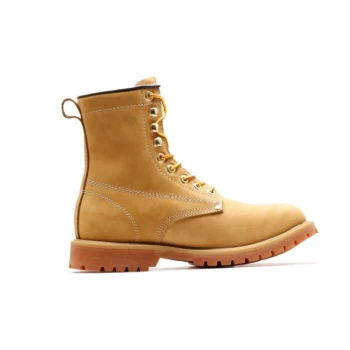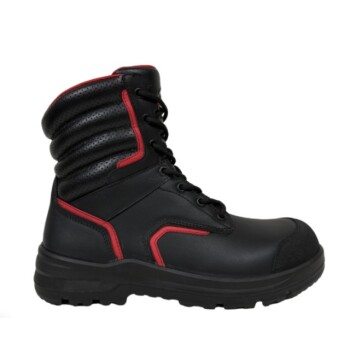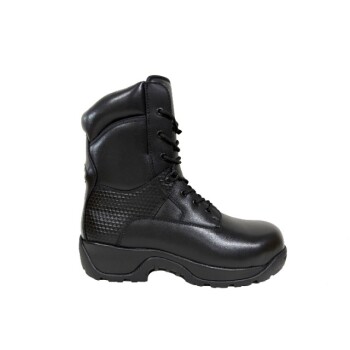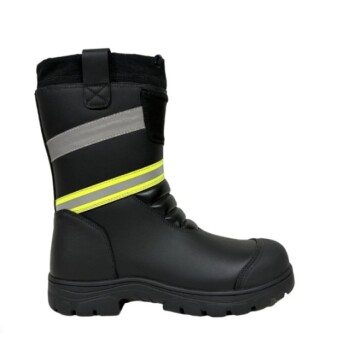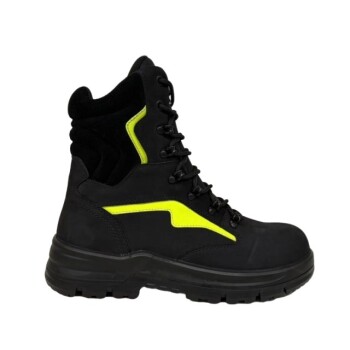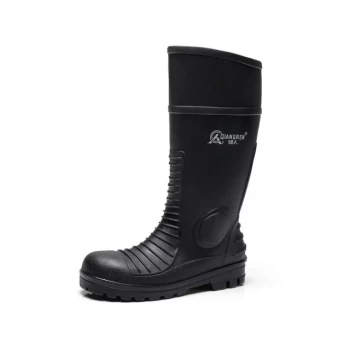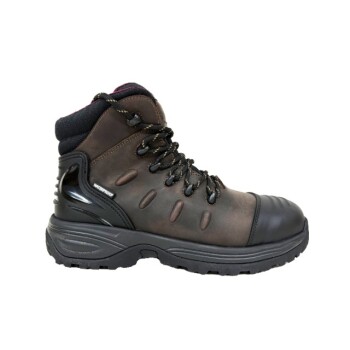At their core, the difference between a cowboy boot and a work boot is one of purpose. A work boot is engineered for safety and stability in demanding environments, while a traditional cowboy boot is designed for horsemanship and Western style. This fundamental difference dictates every aspect of their construction, from the sole and heel to the toe shape and materials.
The central distinction is simple: work boots prioritize on-the-job protection with features like reinforced toes and slip-resistant soles, whereas cowboy boots are built around the specific functional needs of a rider, such as a smooth sole and angled heel for stirrup safety.
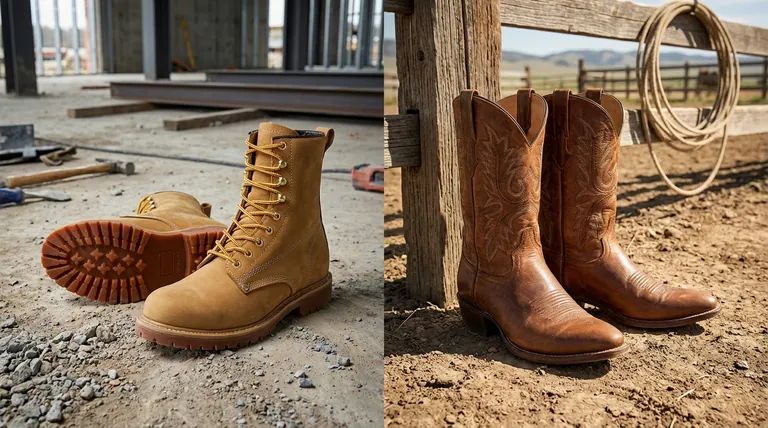
The Anatomy of a Work Boot: Function Over Form
Work boots are purpose-built tools for your feet. Their design is driven by the need to protect the wearer from job site hazards while providing all-day comfort and stability.
The Foundation: Soles Built for Safety
A defining feature of a work boot is its slip-resistant, treaded rubber outsole. This is designed to provide maximum grip on a variety of surfaces, from wet concrete to oily floors, preventing slips and falls.
Protection is Paramount
Most work boots incorporate critical safety features absent in traditional boots. This includes reinforced safety toes (often steel or composite) to protect against impact and compression, as well as puncture-resistant materials in the sole.
A Stable Base for Long Days
Work boots typically feature a low, wide, square heel (often 1.5 inches or shorter). This "block heel" design creates a stable platform for walking on uneven terrain and standing for extended periods, reducing fatigue and the risk of ankle rolls.
Fit and Design Considerations
Work boots are designed with utility in mind, often featuring extra cushioning and support. Designs also differ based on the wearer; women's work boots, for instance, are crafted with a narrower heel and higher arch to match the specific anatomy of a woman's foot for a safer, more comfortable fit.
The Anatomy of a Cowboy Boot: Tradition and Task
The cowboy boot is a highly specialized piece of equipment that evolved for the unique demands of working on horseback. Its iconic features are a direct result of this equestrian heritage.
The Rider's Heel
The classic cowboy boot has an angled heel, typically around 1.5 inches high. This slant is not for style alone; it's designed to prevent the rider's foot from slipping forward through the stirrup, a crucial safety feature.
The High Shaft and Pointed Toe
The tall shaft of a cowboy boot serves to protect the rider's leg from brush, thorns, and snakebites. The traditionally pointed toe helps a rider guide their foot quickly and easily into the stirrup.
The Outsole: Made for the Stirrup
Unlike a work boot's treaded sole, a traditional cowboy boot has a smooth, hard leather outsole. This is essential for allowing the foot to slide in and out of the stirrup without catching, which could be dangerous if a rider were to fall.
An Expression of Cultural Identity
Beyond function, cowboy boots are a symbol of Western style. They often feature ornate stitching and polished leathers, balancing their practical origins with a strong aesthetic tradition that work boots, by design, do not prioritize.
Understanding the Trade-offs
Choosing the wrong boot for the environment is not just impractical—it can be dangerous. The features that make one boot excel in its intended role become liabilities in the wrong context.
The Hybrid Solution: The "Western Work Boot"
Many modern boots bridge the gap between these two categories. A Western work boot combines the silhouette and style of a cowboy boot with the essential safety features of a work boot, such as a treaded rubber sole and a lower block heel for stability.
When Not to Wear a Cowboy Boot
Wearing a traditional cowboy boot on a construction site is a significant risk. The smooth leather sole offers poor traction, the angled heel creates instability for walking, and the lack of a safety toe leaves the foot vulnerable to injury.
When a Work Boot Isn't for Riding
Conversely, wearing a standard work boot for horseback riding can be hazardous. The deep, heavy treads of the rubber sole can easily get caught in a stirrup, creating a serious safety risk if the rider is thrown from the horse.
Making the Right Choice for Your Needs
Selecting the correct boot requires a clear understanding of your primary activity.
- If your primary focus is safety on a job site: Choose a dedicated work boot with a certified safety toe and a high-traction, slip-resistant rubber sole.
- If your primary focus is horseback riding and traditional style: A classic cowboy boot with a smooth leather sole and an angled riding heel is the correct and safest tool.
- If your primary focus is all-purpose farm or ranch work: A Western work boot offers a practical hybrid, providing the durability and safer sole of a work boot with a familiar Western style.
Ultimately, choosing the right boot means matching its specific design features to the demands of your task.
Summary Table:
| Feature | Cowboy Boot | Work Boot |
|---|---|---|
| Primary Purpose | Horsemanship & Western Style | Job Site Safety & Stability |
| Heel | Angled (~1.5") for stirrup safety | Low, wide, block heel for stability |
| Sole | Smooth leather for easy stirrup use | Treaded, slip-resistant rubber for grip |
| Key Safety Feature | Prevents foot from slipping through stirrup | Reinforced safety toe, puncture-resistant sole |
| Toe Shape | Traditionally pointed | Rounded or square |
Need the Perfect Boot for Your Specific Needs?
As a large-scale manufacturer, 3515 produces a comprehensive range of footwear for distributors, brand owners, and bulk clients. Whether you require authentic cowboy boots, certified safety work boots, or durable hybrid Western work boots, our production capabilities encompass all types of shoes and boots.
We can help you:
- Source the right footwear for your target market or workforce.
- Develop custom designs tailored to your specific safety and style requirements.
- Ensure reliable supply with our large-scale manufacturing expertise.
Let's discuss your footwear needs. Contact our team today to get started!
Visual Guide
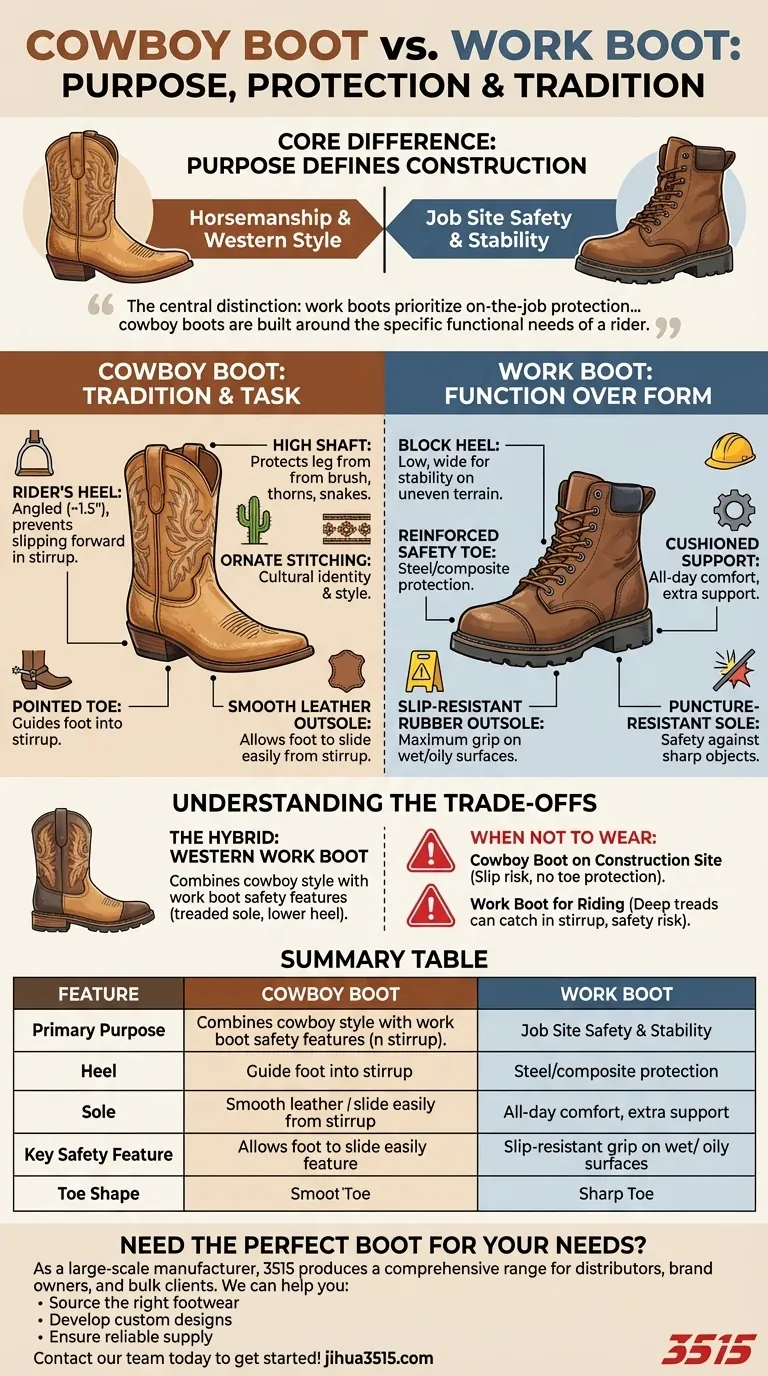
Related Products
- Durable Goodyear Welt Leather Work Boots for Wholesale & Private Label
- Durable Leather Work Boots for Wholesale & Custom Manufacturing
- Durable Leather Work Boots for Wholesale & Custom OEM Manufacturing
- Wholesale Durable Safety Boots Manufacturer Customizable Steel Toe Work Boots
- Premium Wholesale Waterproof Safety Boots High Performance Protection for Industrial Markets
People Also Ask
- How should work boots be stored? Protect Your Investment with Proper Storage
- Which material is the most durable for work boots? Find the Right Boot for Your Job
- Why is the last important in work boot design? It's the Anatomical Blueprint for Comfort & Safety
- What are the cultural perspectives on wearing shoes in the house? A Guide to Home Etiquette & Hygiene
- Is it normal to wear shoes in the house? A Guide to Hygiene, Comfort & Culture
